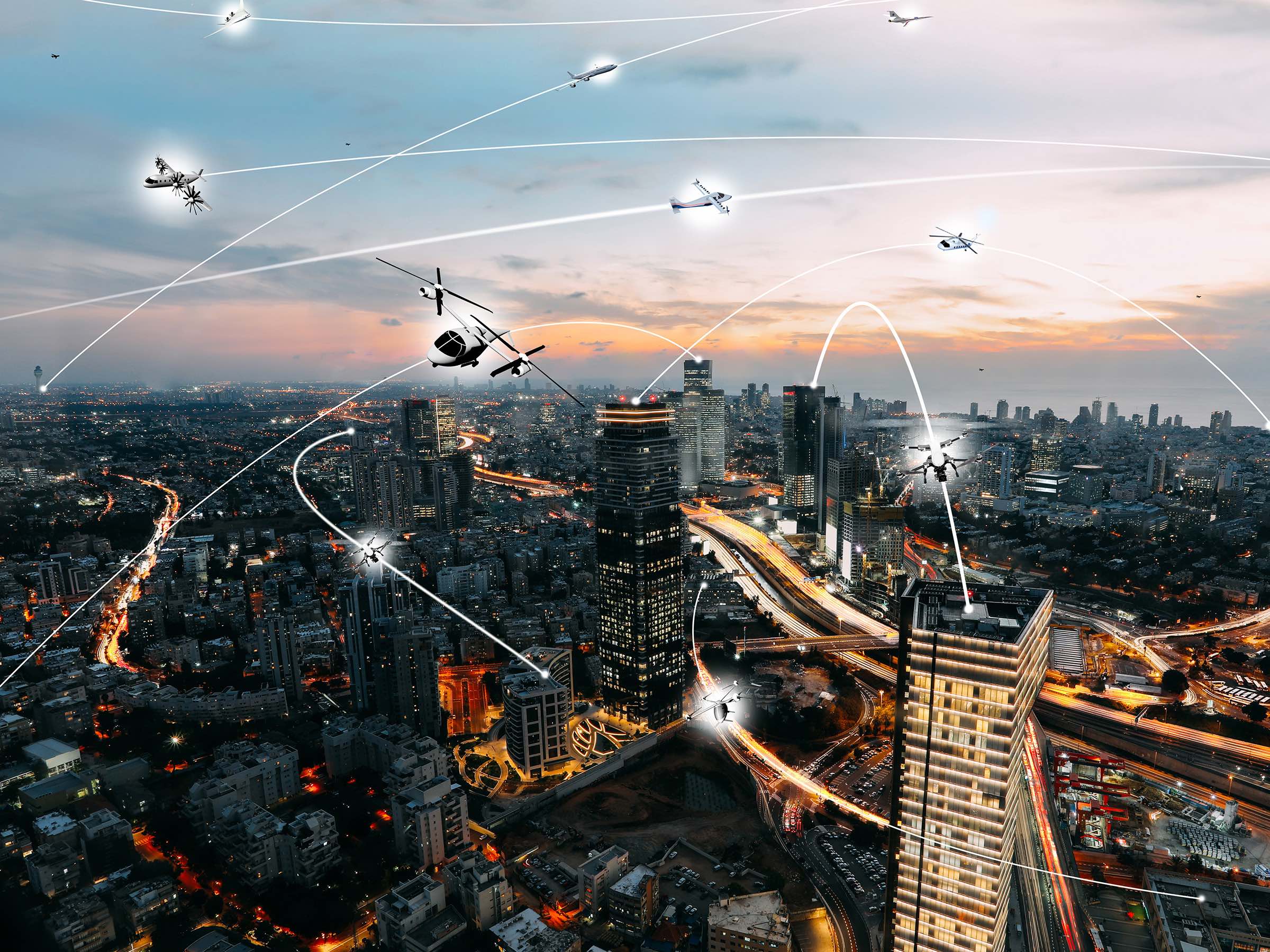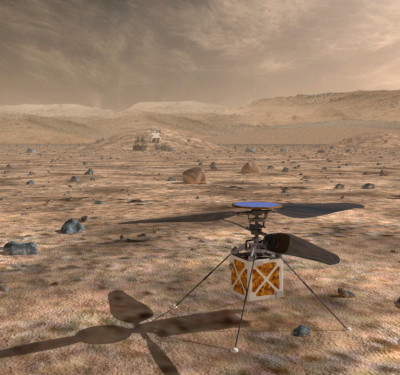
An artist’s conception of an urban air mobility environment, where air vehicles with a variety of missions and with or without pilots, are able to interact safely and efficiently. Photo credit: NASA / Lillian Gipson
That’s the question we’ll take on in our next Inside Unmanned Systems’ Drone Beat podcast series. Believe it or not, we’re only 21 years away from when George Jetson introduced the concept of flying cars for everyone. Few but the truly dedicated ’60s cartoon fans may realize it, but “The Jetsons” was set in 2060–about 100 years from when the series started. There’s a bunch of things in the Jetsons that we probably won’t get in the next two decades–like moving sidewalks everywhere (we need MORE exercise, not less), jetpacks for teens (if you have a teen, you know why), space casinos (OK–we MIGHT get this one)—but there is one thing we CAN get–flying cars for everyone.
How, you ask? As you might expect with a futuristic technology like flying cars, NASA took lead on initial research for flying vehicles for the common person. As you might expect with a large government organization, NASA came up with a boring title for the coolest drone tech we have by calling it “Urban Air Mobility” (UAM). Despite the boring title, NASA attracted some big names to the concept–Uber, Bell Helicopters, Boeing, GE Aviation and Embraer to name a few. They’re all working with one goal in mind: flying cars that anyone can use.
Uber set up a division called “Uber Elevate” to explore the idea of expanding their ride sharing services to the sky. Their concept is to establish drone domes (I just came up with this term, but am willing to trade it to Uber for free drone taxi rides for life) on tall building rooftops in cities. A user would take a conventional Uber to one of these buildings, ride the elevator to the roof and step into their waiting Uber sky taxi. The sky taxi would fly to the drone dome ™ nearest their destination and they’d complete their journey with another Uber to their final destination. Sounds simple, eh?
Well, it’s not. Put yourselves in the FAA’s shoes. Its only been two years since they decided it’s OK to fly under drones under 55 pounds, below 400 feet, not over people and within visual line of sight of the pilot. Drone sky taxis will be way over 55 pounds, fly way over 400 feet, WITH people inside and way, way outside visual line of sight of the pilot. What’s more, drone sky taxis will probably be manufactured with new materials and will almost certainly have electric propulsion. Remember how five-ounce lithium ion batteries in your luggage drives the FAA crazy? Imagine asking to fly batteries weighing hundreds of pounds in drones with people inside and over people outside. Oh–and many of their routes will be to airports, where there are even more things flying around with people in them.
And that’s just the FAA. How will the Department of Homeland Security (DHS) react?One man’s cool drone sky taxi is another man’s giant death drone. Will we really have to go through TSA screening to hop a drone sky taxi across town? I barely put up with TSA to go across the country and I like flying. I’m not sure I’d go through TSA screening for Uber Elevate.
There is hope. It may not sound logical, but the closer a new technology is to old tech missions or markets, the easier it is for the FAA to translate regulations for the new tech. Small drones threw the FAA a curve ball because the only flying vehicle they resembled was something Congress prohibited the FAA from regulating–model aircraft. Hence, the FAA didn’t have a set of rules or policies they could apply to small UAS and it’s been a painful process so far.
Large drones–anything over 55 pounds–have a bunch of manned standards to choose from. Fixed wing and no paying passengers? Got it. Fixed wing and a bunch of passengers? Got it. Rotary wing? Got it. Rotary wing and paying passengers? Got it. Heliports on top of tall buildings in cities? Got it. Wait what?–There’s a standard for rotary wing aircraft that can use rooftops in cities AND fly over people while they’re doing it? That sounds suspiciously like what Uber, Bell, Boeing, GE and Embraer are trying to do . . .
It may not make sense to the general public, but UAM is a market where the FAA can make rules. They may not understand small, model airplane-sized drones delivering packages in cities, but they do understand helicopters landing on rooftops in cities to take people to airports. That means that Uber Elevate and their supporters are now in a much easier debate with the FAA to highlight the differences between manned helicopters ferrying paying passengers around cities and unmanned helicopters doing the same thing. That, the FAA can understand.
Hence, Uber and supporters only have to explain the differences between manned helicopters carrying passengers and unmanned helicopters carrying passengers and that’s easier than it sounds. Small commercial drone advocates are already helping explain how drones can see and avoid collisions and conduct autonomous operations better than manned aircraft. All Uber and supporters must do is explain how those electric engines and pesky giant lithium ion batteries are just as safe as jet engines and jet fuel. That’s a tough one, but do-able.
Uber Elevate might take on DHS in a similar manner. DHS already has mechanisms to vet airlines for security procedures they can apply to Uber Elevate operating as an airline. They also have a screening partnership program that would allow Uber to screen passengers itself, to TSA standards. I think Uber also has a viable argument that TSA should change standards for drone taxis. Current standards are aimed at either preventing passengers from hijacking an aircraft or bringing a bomb on board. There would be no pilot to threaten on a drone taxi and proper cyber security would make it very difficult for a drone passenger to hijack the aircraft. The threat of bombs on drone taxis is no greater than bombs on conventional taxis, trains or busses and TSA doesn’t scan those passengers. True, a drone taxi crash after a bomb attack would cause more damage than a conventional taxi crash, but not more than a crashing bus or train. Uber would already mitigate risk from conventional crashes by flying over lower populated routes and this would help in a terrorist attack. Designers could also reduce damage by lining luggage compartments with Kevlar or creating blow out panels to direct a blast outside the aircraft. TSA could possibly treat drone taxi passengers like they do ground transportation passengers with these measures in place.
Can we do all this in 21 years and beat George Jetson to autonomous sky cars for everyone? I think so. I wouldn’t be optimistic in five years but I’m pretty sure not even the FAA and DHS combined can stop this great idea from happening given two decades of preparation time and the hard work of people like Uber, Bell, Boeing and Embraer!
We’ll release the Drone Beat Urban Air Mobility series on iTunes, Google Play, Sound Cloud and www.insideunmannedsystems.com in July. Search for “Drone Beat Inside Unmanned Systems,” subscribe and listen to us monthly!






